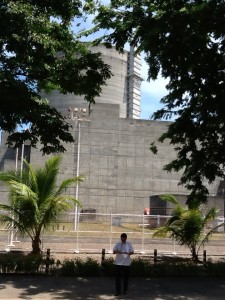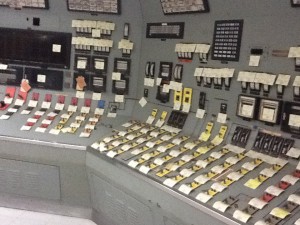 In Britain there has been a trend over the past thirty years or so to convert old farm buildings and factories into beautiful homes. It is hard to imagine doing the same kind of recycling with the empty nuclear power plant in Bataan, but what can one do with a monstrous monolith of concrete, unlikely ever be used for what it was intended?
In Britain there has been a trend over the past thirty years or so to convert old farm buildings and factories into beautiful homes. It is hard to imagine doing the same kind of recycling with the empty nuclear power plant in Bataan, but what can one do with a monstrous monolith of concrete, unlikely ever be used for what it was intended?
In the face of the oil crisis in the 1970s, the Philippine government began construction on a nuclear power plant on the west Luzon coast, south of Subic, and sixty miles across the South China Sea to Manila. A vast fortune would be spent to build this altar to sustainable energy, before leaving it to rot without ever having switched it on.
After the nuclear accident at Three Mile Island in Pennsylvania in 1979, President Marcos suspended the Philippine nuclear project. A subsequent safety inquiry uncovered 4,000 defects. Plans were upgraded and construction resumed in 1981.
By 1986 the plant was safely completed, but costs had sky-rocketed to US$2.3 billion, including US$60 million worth of fuel (uranium) already delivered to the plant. In a series of ill-timed coincidences, the People Power Revolution against the Marcos regime culminated that same year and led to a change in leadership, while the horrific nuclear disaster at Chernobyl in Eastern Europe caused strong opposition to the plant from the Filipino citizens fearing its proximity both to earthquake fault lines and the dormant Mount Pinatubo, part of a chain of volcanos along the west coast of Luzon. The new President of the Philippines, Corazon Aquino, deemed it safer to defer the opening and put the plant on ice, where it has stayed, frozen in time, ever since.
Despite its non-operational status, debt repayment on the Bataan power plant would remain one of the government’s largest obligations for the next three decades. Today it continues to be maintained at considerable cost, although it is now slightly worn around the edges. While the aging and corpulent power plant settles mutely, ineffectually, on a bare promontory, proposals to convert it into an oil, coal, or gas-fired power station have all been discussed and discarded.
 Last year it was decided to open it up to the public as a tourist attraction to raise funds for it maintenance. It also appears to have re-opened the debate on whether or not to finally turn the plant on. Tours of the plant and a short preliminary lecture about alternative fuel sources seem unlikely to bring in enough pesos to justify its existence, however, unless they can develop the idea further, with perhaps a restaurant, a theme park or at least some souvenir t-shirts. Or maybe they could take a tip from the Taiwanese, who, with inspired marketing, have created a comic strip character from the huge wind damper in Taipei’s tallest tower: Damper Baby!
Last year it was decided to open it up to the public as a tourist attraction to raise funds for it maintenance. It also appears to have re-opened the debate on whether or not to finally turn the plant on. Tours of the plant and a short preliminary lecture about alternative fuel sources seem unlikely to bring in enough pesos to justify its existence, however, unless they can develop the idea further, with perhaps a restaurant, a theme park or at least some souvenir t-shirts. Or maybe they could take a tip from the Taiwanese, who, with inspired marketing, have created a comic strip character from the huge wind damper in Taipei’s tallest tower: Damper Baby!
Notwithstanding the lack of souvenir shops, the temptation to explore the innards of an almost working nuclear plant was irresistible. In the grinding heat, we drove north through rice fields and then south into the hills and down the west coast to the well-guarded site overlooking the South China Sea.
As we emerged from the trees onto the cleared land that acts as a nuclear buffer, the Bataan nuclear power plant loomed above us in all its grey concrete glory. From a distance, it looked like a ruined Roman fortress, guarded by a large flock of goats. It reminded me of the Australian satellite dish that squats like a vast mushroom in a sheep paddock in Parkes, New South Wales.
 Leaving our cars in the shade, we proceeded to the office block outside the perimeter fence for our introductory talk. No occupational health and safety talk, merely a short introduction to alternative power sources. Then the guide led us along the perimeter fence, to the gate house where we crossed through the security machine – cutting edge technology in its time, now looking like a prop in a 1970s sci-fi movie.
Leaving our cars in the shade, we proceeded to the office block outside the perimeter fence for our introductory talk. No occupational health and safety talk, merely a short introduction to alternative power sources. Then the guide led us along the perimeter fence, to the gate house where we crossed through the security machine – cutting edge technology in its time, now looking like a prop in a 1970s sci-fi movie.
I don’t suppose power plants are designed with any aesthetic purpose in mind, but close up, although impressive, this titanic pile of concrete is truly ugly. We walk round to a side door, stunned by the heat and the magnitude of the building. Inside it feels grim and airless. The dim light and the large scale tanks and pipes add to the sense of oppression, and as the perspiration poured down my back, I could feel a panicky sense of claustrophobia rising in my throat.
I swallowed it back and made a joke of sliding on the shiny concrete floors. We moved on, and up a flight of metal stairs – the sort made of metal grills – and I suddenly understood why we were asked to wear flat shoes! At the top of the staircase we clambered through the safety chamber with its double heavy metal doors and into the reactor core. Although this has never been activated, the photos taken in here gave off a suspicious glowing green light – a great theatrical effect.
 Peering through a gap in the walkway, we could see the fuel rod casing several feet below, still wrapped in plastic and sitting high and dry where it should have been immersed in the deep, now empty, water tank or reactor.From here we tiptoed up and down a couple more metal staircases to reach the control room, which really does look like something out of an old Star Trek or Thunderbirds episode. There is a special observation room with one way glass so we would not distract the operators (Fat Controllers?), but of course the control room has never been manned and we were free to wander past the panels of labelled switches.
Peering through a gap in the walkway, we could see the fuel rod casing several feet below, still wrapped in plastic and sitting high and dry where it should have been immersed in the deep, now empty, water tank or reactor.From here we tiptoed up and down a couple more metal staircases to reach the control room, which really does look like something out of an old Star Trek or Thunderbirds episode. There is a special observation room with one way glass so we would not distract the operators (Fat Controllers?), but of course the control room has never been manned and we were free to wander past the panels of labelled switches.
Our final stop was in a huge hall that contains the Westinghouse turbine that spins the generator to create electricity from the steam produced by the reactor.
In such a poor country, where domestic electricity is enormously expensive, it seems a crime not have opened the plant and developed a cheaper power source. On the other hand, subsequent events indicate that perhaps President Aquino made the right decision in closing down the plant.
In July 1990, a major earthquake measuring 7.7 on the Richter scale struck central Luzon about 100 km northeast of Pinatubo. During March 1991, a succession of earthquakes rumbled beneath villages on the northwest side of the volcano. In April the volcano began to murmur, and activity increased throughout May and early June. On June 15 an enormous volcanic eruption devastated the region and hundreds of local communities, exacerbated by a tropical storm that hit the coast at the same time.
Proof, then, that Aquino made the right decision. Yet the questions still hang heavily in the air: what to do with it now? And how to recoup some of the billions wasted on its construction?
In the meantime, however, it makes an interesting and rather out-of-the-ordinary day trip. Although I would have liked the opportunity to buy the t-shirt!

